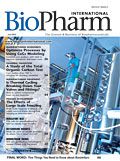Large-Scale Freezing of Biologics: Understanding Protein and Solute Concentration Changes in a Cryovessel—Part I
ABSTRACT
The freezing and thawing of bulk protein solutions maximizes production capacity while enabling drug product logistics to be better aligned with market demands. Freezing also eliminates risks from stress during transport and minimizes the possibility of microbial growth. However, the potential for freezing-induced aggregation, caused by cryoconcentration, crystallization of solutes or buffer salts, pH changes, and ice water interface-induced denaturation, results in significant challenges for success with this unit operation. From a processing standpoint, freezing and thawing rates measured on the basis of the time required to complete phase transition and storage temperature in relation to the glass transition temperature are critical parameters. This two-part article focuses on freezing protein solutions with an active freeze–thaw system called the cryovessel. Part 1 of this article presents results from a detailed mapping of solute distribution and solution property changes during the freezing stage for various processing rates as a function of position in the cryowedge. Part 2 of this article will present results from examination of the frozen state itself. Data has been generated on a scaled-down model, called the cryowedge, to simulate the freezing and thawing process in a cryovessel. The results illustrate the extent of changes in various solution properties that occur during freezing at different rates.
Freezing and thawing large volumes of protein bulk drug substance (BDS) has become an important step in the manufacture of biotherapeutics. Producing biologics is an expensive process and to optimize capacity use, the BDS is often produced in large manufacturing campaigns. The bulk solution is converted into drug product based on market demand, and therefore may have to be stored for relatively long periods of time. To decouple the production of the bulk solution from that of the drug product, the bulk is often stored in the frozen state. Other advantages of this storage option include slower chemical degradation kinetics, minimizing microbial growth and the eliminating transportation stress by reducing air–water interfaces.1-3 A successful bulk storage program enhances bioprocess capacity use and reduces the overall cost of production.
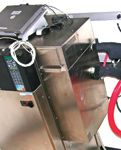
(PFIZER, INC.)
Despite the advantages of freezing BDS, the freeze–thaw process itself offers numerous challenges because of the complexity of the changes that occur and the poor understanding of how the solutes, including the protein, are affected. Although a number of studies have been published on the impact of freezing proteins, these are limited to small or microscopic volumes where process conditions become irrelevant compared to practical BDS freezing systems. In studies where the rate is taken as a study parameter, this mostly refers to the rate of cooling (i.e., the rate at which the temperature is lowered down to the freezing point).4 However, the more critical parameter is the time taken to actually freeze the solution (the phase transition time), because it is during this stage that cryoconcentration, solute redistribution, phase separation, ice-interface creation, eutectic crystallization, glass formation, pH change, and other freezing-related changes occur. A number of these phenomena can be destabilizing to the protein structure as it cryoconcentrates along with the other solutes during this phase transition freezing stage before complete solidification. Protein molecules that have become (partially or fully) unfolded during the freezing stage potentially can lead to aggregate formation over time because these unfolded molecules serve as nuclei and interact with their neighbors if enough mobility is afforded to the system by storage above or near the glass transition temperature (Tg'). The outcome of the process in terms of the stability of protein on frozen storage is likely to be significantly determined by what occurs during the freezing stage.1,2
Time required to freeze the solution (i.e., the time to complete the phase transition) is dependent on the volume or mass to be frozen and the rate of heat removal. Literature studies using slow or fast rates mainly have used small volumes where the time required for freezing, even when described as slow, is much shorter than for practical systems involving the processing of tens to hundreds of liters of solution. Furthermore, when the heat and mass transfer dimensions are small, significant solute movement and cryoconcentration effects are not in place before immobilization traps the solutes. Thus, while fundamental phenomena such as ice-interface effects, phase separation, eutectic crystallization, and pH change can be explored in small-volume studies, the effect of cryoconcentration and solute redistribution, or time in phase transition, require studies to be conducted at scales or dimensions more representative of the full-scale process. A fundamental mechanistic understanding of the behavior of a representative-scale system undergoing freeze–thaw processing will enable better definition of the process parameters to minimize the impact of processing on protein drug substance.
Several options are used in the biotech industry for freezing biologics. These include passive systems such as bottles or carboys, and active systems such as tanks with coolant circulation (such as CryoVessels, Sartorius-Stedim Biotech, Aubagne, France; and FreezeContainer, Zeta Holdings, Styria, Austria) and large-scale bag freezing systems (Celsius, Sartorius-Stedim). Various studies have been published on solute distribution in such freezing systems, although primarily in frozen state.5–9 However, a thorough study of the evolution of solute distribution during the freezing process, especially in a cryovessel, is not available. Additionally, the connection between concentration changes during freezing and cryoconcentration in the frozen state has not been explored. It has been shown that cryoconcentration in the frozen state is maintained to a great extent if thawing is performed in a static manner.10,11 In this paper, we have focused on mapping cryoconcentration behavior in large scale systems. Through a series of experiments, we have investigated the solute distribution pattern in a Cryowedge (Sartorius-Stedim) when a protein solution is subjected to various freezing cycles. The cryowedge geometry represents a scaled-down model for commercially available controlled rate freeze–thaw systems called CryoVessels. The heat and mass transfer surfaces or distances in the wedge are identical to those in a cryovessel of corresponding size, so that the freeze and thaw behavior of a full-scale vessel can be studied at a laboratory scale. The study was conducted on a Cryowedge 34, which is representative of a 300-L cryovessel. This article (Part 1) presents results from a detailed mapping of solute distribution and solution property changes during the freezing stage at various processing rates as a function of position in the cryowedge. Part 2 of this article will present results from an examination of the frozen state itself.
MATERIAL AND METHODS
Materials
Solute distribution and solution property changes during freezing (at three different freezing rates) and in the frozen state were monitored in a Cryowedge 34. Processing was carried out by a Cryoprocessor B using silicone oil as the heat transfer fluid (HTF) (Syltherm, Dow). Figure 1 shows the Cryowedge when the solution is completely frozen, along with the custom-made sample ports that are marked as positions 0 through 8. Thermocouples used to monitor the process were inserted at positions 1 through 5.
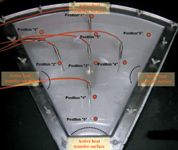
Figure 1. Sample ports and positions on the Cryowedge showing the placement of thermocouples that monitor the temperature changes at the respective positions during the freezing and thawing process. The active heat transfer surfaces are identified; these comprise the full top and bottom edges, as well as the dotted regions on the left and right hand edges.
The model protein for this study uses an in-house IgG2 monoclonal antibody (MAb) solution at 20 mg/mL in a 20 mM histidine buffer, pH 5.5 with 0.2 mg/mL polysorbate 80, 84 mg/mL trehalose dihydrate.
Cryowedge Solution Mapping During Freezing
Cryowedge solution mapping was performed for three freezing process profiles, designated as slow, intermediate, and fast. The intermediate profile was suggested by the manufacturer to best represent freezing in a 300-L tank. The profiles are illustrated in Figure 2 along with the solution temperature recorded by the thermocouples at positions 1 through 5 during a typical freezing run. Approximately 4 L of either the formulation buffer solution or MAb solution was added to the cryowedge and covered with a plexiglass lid. The freezing process was initiated per the identified profile, and at predetermined intervals, liquid samples of ~500 µL were withdrawn from all the sample ports, until the liquid underneath the sample port became completely frozen. These liquid samples were withdrawn by attaching a BD spinal needle (18G, 6 inch length) to a 3-mL BD syringe and passing the needle through the sample using the thermocouple port of the Cryowedge. Using a narrow needle for the liquid sample, we attempted to obtain the "mother liquor" without dilution by any ice crystals that may have formed at that position. These samples were analyzed for pH, glass transition temperature (Tg'), osmolality, high molecular mass species (soluble aggregates) by size exclusion chromatography (SEC), and protein concentration.
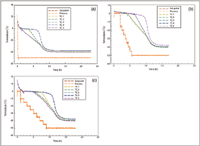
Figure 2. Temperature profiles for (a) fast freezing, (b) intermediate freezing, and (c) slow freezing processes. The actual temperatures recorded by five thermocouples (labelled as TC 1â5) at the various positions indicated in Figure 1 also are shown.
RESULTS
The objective of mapping the solution properties during the freezing process and after freezing (described in detail in Part 2) was to determine how solute and protein concentration changes evolve during the freezing of the liquid phase and to compare these concentrations to the final distribution in the frozen solid phase. The freezing time of the process is defined as the time interval between the first probe to reach 0 °C and the probe at position 3 to read –20 °C.
Mapping of Solute and Protein During Freezing
Solution samples removed during freezing were analyzed for pH, osmolality, Tg', protein concentration, and soluble aggregates.
Fast Freezing Process
The fast freezing process profile is shown in Figure 2a. In this cycle, the process temperature is reduced to –50 °C and held for an extended time to achieve the fastest freezing rate possible in the wedge. Positions 0 and 7 are the first to freeze, followed by positions 2, 4, 8, and 6. The longest time to freeze is observed at position 3, preceded by positions 1 and 5 (Figure 2a). Slight (approx. 1 °C) supercooling is seen at positions 2 and 4. The last point to freeze (position 3) is a factor of the geometry of the wedge and (heat-transfer capacity weighted average) distance from the actively cooled surfaces as shown in Figure 1. The time taken to complete the freezing process (defined as above) for this run was 391 minutes (Figure 2a).
Figure 3a shows the osmolality values obtained for formulation buffer solution when the solution was subjected to the fast freezing process. A significant osmolality increase is observed at position 3, followed by smaller increases at positions 1 and 5. The initial osmolality level for the formulation buffer was 256 mOsm/kg. The highest osmolality value measured was 667 mOsm/kg, representing cryoconcentration by a factor of approximately 2.6 compared to the initial. The solutes in the formulation buffer progressively migrate (by diffusion or convection) toward position 3 as the freezing progresses. The osmolality values at the other positions (before completion of freezing at that position) ranged from 242 to 302 mOsm/kg with a minimum observed at position 7. In general, except for the last stages of freezing at positions 1, 3, and 5, the osmolality values range between 228 and 274 mOsm/kg (compared to initial of 256 mOsm/kg). No significant changes in the pH of the solution were observed during freezing (in liquid state), with pH ranging from 5.55 to 5.63 (not shown). The corresponding Tg' of the solutions removed from these positions also showed no significant changes, ranging from –30.6 °C to –31.5 °C (data not shown). The pH and Tg' results show that there is no significant partitioning or separation of the components of the solution during the freezing process.
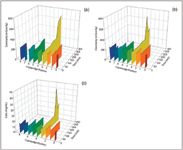
Figure 3. Changes in (a) solution osmolality of formulation buffer, (b) solution osmolality of MAb solution, and (c) protein concentration as a function of position in the cryowedge and time during the fast freezing process.
Figure 3b shows the osmolality values obtained at different positions of the cryowedge as a function of time with the MAb solution undergoing the fast freezing process. A maximum osmolality value of 705 mOsm/Kg was observed at position 3. The lower osmolality value observed at the later time point is likely an artifact of sampling, because at this point in the cycle, a significant amount of ice crystals are present at this position. It is possible that some ice crystals were drawn into the syringe along with the unfrozen solution, resulting in dilution. The observed maximum osmolality value is not significantly different compared to that seen with the formulation buffer (Figure 3a), suggesting that the formulation buffer and the MAb solution behave similarly. The time taken to complete the freezing process (–20 °C at position 3) for this run was 442 minutes. The protein concentration trend was similar to the osmolality trend, showing a peak concentration of 41.9 mg/mL (a 2.2-fold increase compared to initial concentration of 18.8 mg/mL) (Figure 3c). Again, except for the last stages of freezing in positions 1, 3, and 5, the measured MAb concentration ranges from 17.6 to 17.9 mg/mL. Soluble aggregate levels, measured by size exclusion chromatography, did not show any difference between the samples, indicating that an increase in local protein concentration did not have any impact on soluble aggregate levels for this MAb solution in the experimental time frame (SEC was performed within 15 days, and all aliquots were stored at 2–8 °C; data not shown). No substantial variations were observed for pH (range 5.48 to 5.58) or Tg' (range –28.3 to –30.4 °C; data not shown).
Intermediate Freezing Process
Freezing by the intermediate process comprises an equilibration step for the solution at 0 °C with the mixer turned on for 2 h to ensure homogeneous solution composition and temperature. After 2 h, the process temperature was decreased in steps of 5 °C after every 30 min with a final temperature of –50 °C. The freezing time was approximately 8.2 h (Figure 2b). Figure 4a shows the osmolality values obtained for the formulation buffer solution with this freezing profile. A maximum osmolality value of 839 mOsm/kg was observed for position 3 followed by 522 and 500 mOsm/kg at positions 1 and 5 respectively. The observed osmolality value at position 3 was just marginally greater than that obtained from the fast freezing cycle (Figure 3a). Except for the last stages of freezing, the osmolality ranged from 227 to 283 for all positions. When the osmolality values for fast freeze and intermediate freezing cycles are compared, it can be concluded that the solute distribution during freezing varied little between the two cycles even though the freezing rates were significantly different. The values of pH and Tg' ranged from 5.61 to 5.68 and –30.9 to –31.3 °C, respectively, for all positions (not shown).
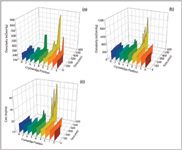
Figure 4. Changes in (a) solution osmolality of formulation buffer, (b) solution osmolality of MAb solution, and (c) protein concentration as a function of position in the cryowedge and time during the intermediate freezing process.
Figure 4b shows the osmolality values obtained when the MAb solution was subjected to the intermediate freezing process. The highest osmolality values were observed for position 3, with the maximum measured as 889 mOsm/kg. The similarity between osmolality values for formulation buffer and the MAb solution for the intermediate freezing profile suggests that the presence or absence of protein during the freezing process had little effect on solute distribution. Protein concentration values provided the same trend as osmolality values, with the highest protein concentration being 48.1 mg/mL, an approximately 2.6-fold cryoconcentration (Figure 4c). Except for the last stages of freezing, the protein concentration ranged from 17.4 to 18.2 mg/mL for all positions. The changes in pH and Tg' values were minimal for all the samples (data not shown). In addition, soluble aggregate levels for all the samples, including the high osmolality and concentration samples, did not show any apparent increase (data not shown).
Additionally, a thaw process profile was run on the frozen MAb solution. After 1,020 minutes, the temperature was increased to –25 °C and thereafter every 15 minutes to 2 and 25 °C and held at 25 °C with the mixer on during thawing. Analysis of the samples taken from the thawed solution showed that mixing during thawing had redistributed the protein and solutes uniformly with no observable impact on soluble aggregate levels.
Slow Freezing Process
Temperature profiles for the slow freezing profile are shown in Figure 2c. Supercooling was recorded in this case at all thermocouple positions in the cryowedge. A remarkable nucleation phenomenon was observed visually. Ice nucleation began at the heat transfer surfaces and rolled across the cryowedge in about 1 min, leaving the whole solution opaque with ice crystals or nuclei. Some of these nuclei melted back, as evidenced by a slight clearing of the solution over time. Complete solidification followed the time course per Figure 2c. The time required for freezing was 598 minutes (defined as before). Osmolality values obtained for formulation buffer are shown in Figure 5a. The maximum osmolality value of 1391 mOsm/kg was measured for position 3. This maximum osmolality value for the slow freezing of formulation buffer was significantly greater than in the other processes. The slow rate of freezing allowed a greater time for diffusion or convective movement and thus produced a greater degree of cryoconcentration. Except for the last stages of freezing the osmolality ranged from 221 to 305 mOsm/kg for all positions. As expected, these values were lower than those seen in Figures 3a, 4a, and 5a. Again, no apparent changes in either pH or Tg' values were observed.

Figure 5. Changes in (a) solution osmolarity of formulation buffer, (b) solution osmolarity of MAb solution and (c) protein concentration as a function of position in the cryowedge and time during the slow freezing process.
Osmolality values for the MAb solution frozen by this slow process are shown in Figure 5b. The maximum osmolality observed was at position 3 followed by position 1, with values of 778 and 770 respectively. The maximum in this case was significantly lower than that in Figure 5a. We attribute this difference to a possible sampling discrepancy. The protein concentration reached 41.8 mg/mL, approximately 2.33-fold higher than the initial value of 17.9 mg/mL (Figure 5c). The soluble aggregates level did not change, nor did the pH or Tg' (data not shown).
DISCUSSION
A comprehensive picture of freezing behavior in a Cryowedge 34 (representative of a 300-L cryovessel) has been obtained for a number of freeze profiles. The concentration changes in the liquid phase as the solution freezes were monitored, based on protein concentration and osmolality measurements. The last point to freeze shows the highest concentrations, whereas the regions close to the heat-transfer surfaces are depleted of solutes. Our results with various rates of freezing demonstrate that a slower freezing rate allows a higher degree of concentration polarization to occur. Slower freezing enables pure ice crystals to grow slowly into the solution without trapping solutes, hence increasing the solute concentration in the unfrozen liquid phase. Diffusion and convection rates of the solutes in competition with the overall freezing (ice formation) rate determines the distribution of the solutes.
CONCLUSIONS
We have systematically analyzed solute distribution and solution property changes during freezing for various process profiles in a cryowedge, representative of a 300-L cryovessel. Our results suggest that during freezing, as water from solution is converted into ice, it pushes the solute toward the center resulting in a macroscopic cryoconcentration (discussed further in Part 2). A >2-fold increase in protein concentration was observed for all the freeze profiles. A >4-fold increase in osmolality was observed for the slow freeze cycle, whereas the increase in osmolality for the intermediate and fast freeze cycles was >2-fold. No significant differences in pH, Tg', or soluble aggregates were observed.
Parag Kolhe is a principal scientist, Alanta Lary is a senior scientist, Steven Chico is an associate scientist, Elisabeth Holding was an associate scientist, and Satish K. Singh is a research fellow all at Pfizer, Inc., Chesterfield, MO, 636.247.9979, satish.singh@pfizer.com
REFERENCES
1. Singh SK, Kolhe P, Wang W, Nema S. Large-scale freezing of biologics—a practitioner's review, part one: fundamental aspects. Bioprocess Int. 2009;7(10):32–44.
2. Singh SK, Kolhe P, Wang W, Nema S. Large-scale freezing of biologics—a practitioner's review. Part two: practical advice. Bioprocess Int. 2009;7(11):34–42.
3. Singh SK. Storage considerations as part of the formulation development program for biologics. Am Pharma Rev. 2007;10(3):26–33.
4. Bhatnagar BS, Bogner RH, Pikal MJ. Protein stability during freezing: separation of stresses and mechanisms of protein stabilization. Pharm Dev Technol. 2007;12(5):505–23.
5. Lashmar UT, Vanderburgh M, Little SJ. Bulk freeze–thawing of macromolecules effects of cryoconcentration on their formulation and stability. Bioprocess Int. 2007;5(6):44–54.
6. Tschoepe M, Schmidt R. Impact of freeze/thaw processing on monoclonal antibody stability. Bioprocess International Conference. Vienna, Switzerland. April 2008.
7. Webb SD, Webb JN, Hughes TG, Sesin DF, Kincaid AC. Freezing biopharmaceutical using common techniques and the magnitude of bulk scale freeze-concentration. Bioprocess Int. 2002;15(5):22–34.
8. Wisniewski R, Wu VL. Large-scale freezing and thawing of biopharmaceutical products. In: Avis KE, Wu VL, editors. Biotechnology and biopharmaceutical manufacturing, processing, and preservation. Interpharm Press, Buffalo Grove, IL. 1996:7–60.
9. Zippelius R. Untersuchung zum Enifrier- und Aufauverhalten Pharmazeutischer Humanproteinlosungen im Grossmasstab. (Investigation of Freezing and Thawing Process of Human Pharmaceutical Protein Solutions at Large Scale). PhD Thesis (in German), Ludwig-Maximilians University, Munich, 2002.
10. Kolhe P, Badkar A. Protein and Solute Distribution in Drug Substance Containers During Frozen Storage As Well As Post-Thawing: A Tool To Understand and Define Freezing-Thawing Parameters in Biotechnology Process Development Submitted 2009.
11. Maity H, Karkaria C, Davagnino J. Mapping of solution components, pH changes, protein stability and the elimination of protein precipitation during freeze-thawing of fibroblast growth factor 20. Int J Pharm. 2009;378(1-2):122-135.
